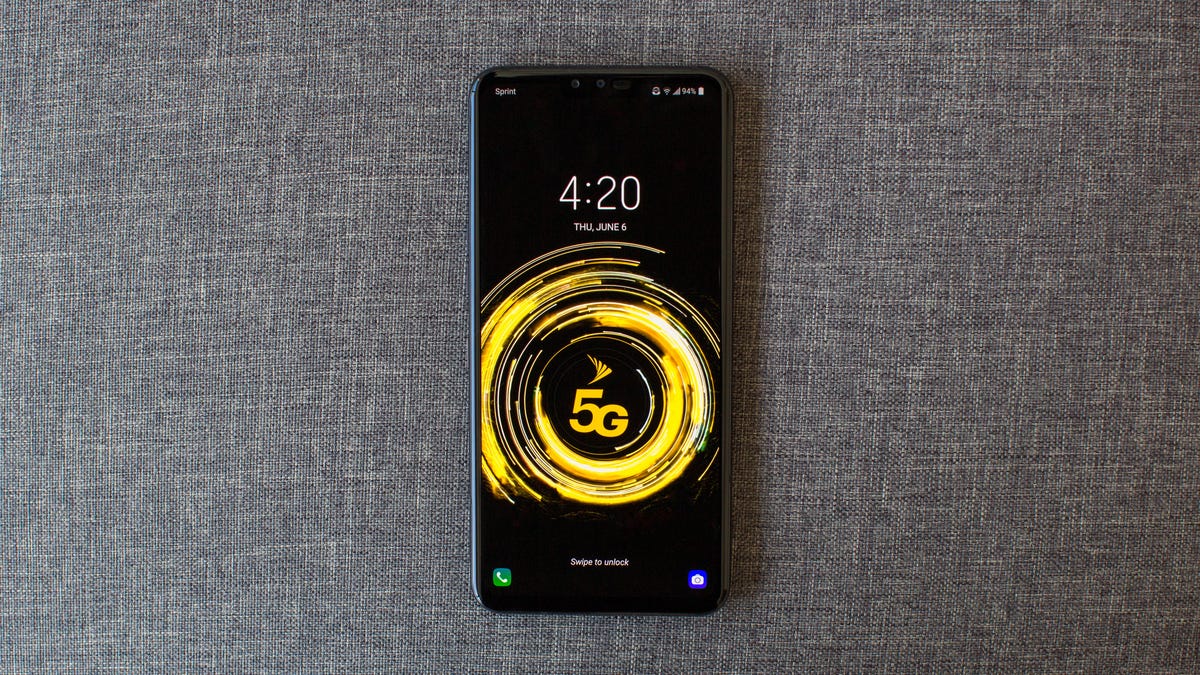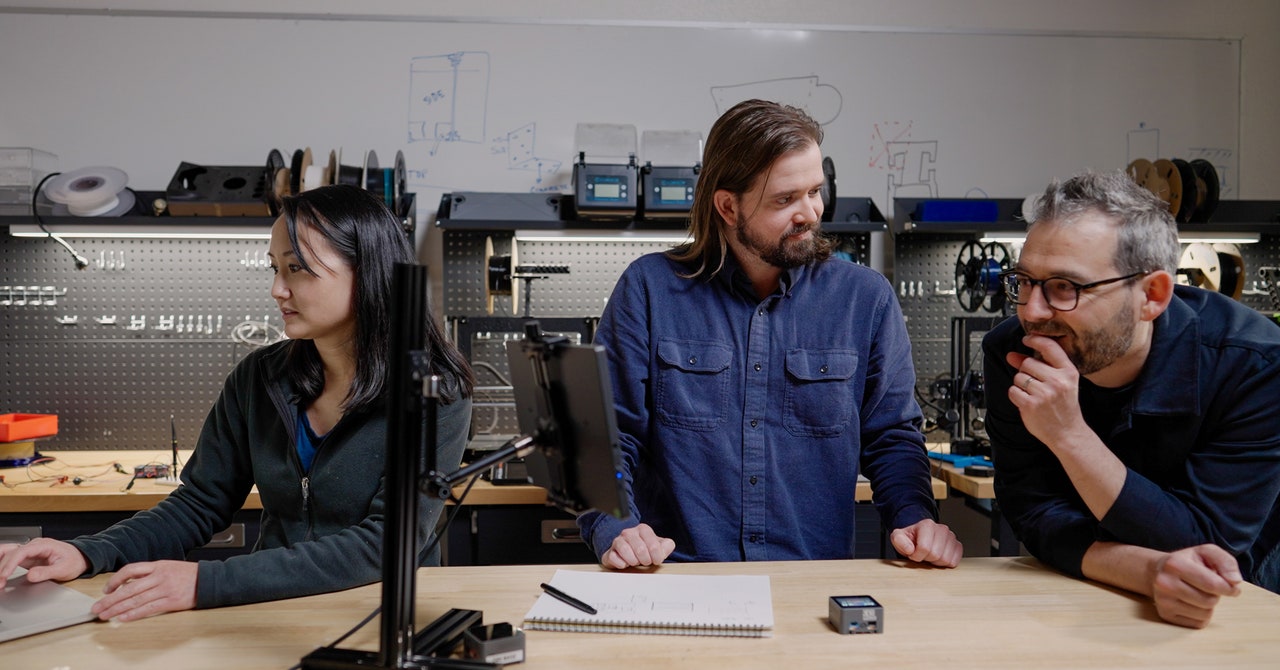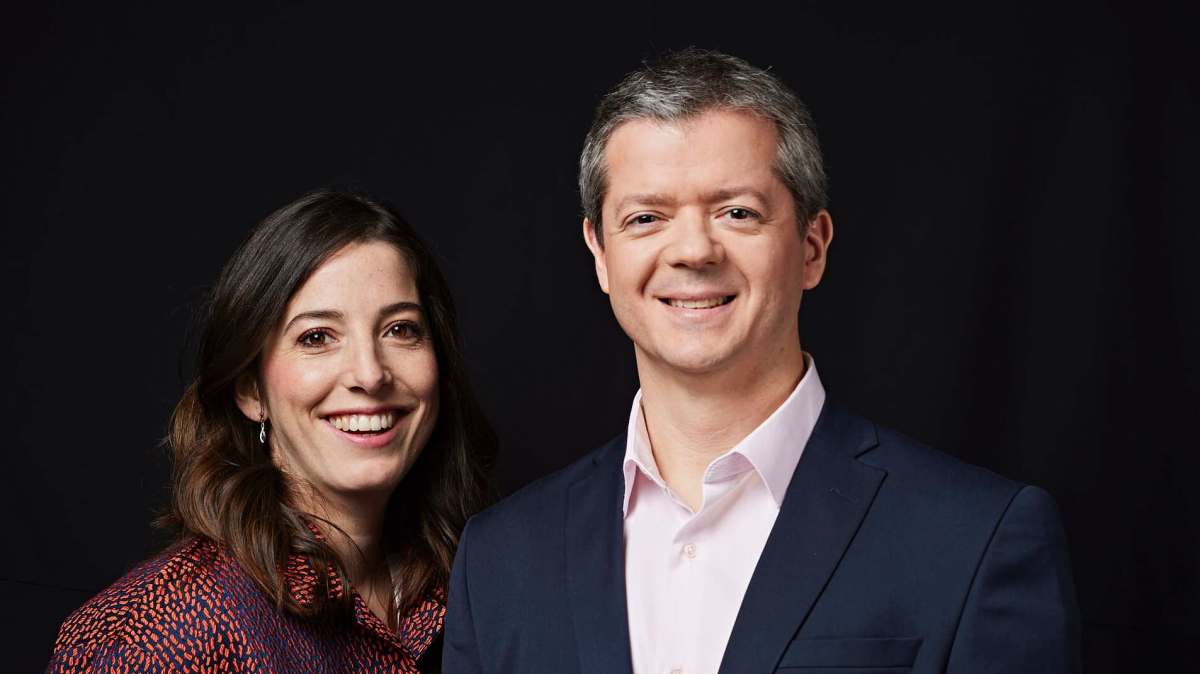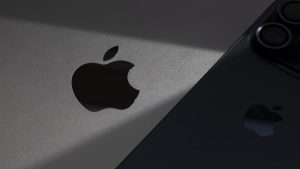LG V50 ThinQ review: Too soon for 5G
LG just announced an upgraded version of the G8 called the LG G8X, which among other features is compatible with a dual screen attachment, similar to the LG V50.
The Good
The water resistant LG V50 has a big, sharp display, five cameras that take a bunch of different kinds of photos, a headphone jack and 5G connectivity.
The Bad
The phone is expensive if you don’t use much 5G and it lacks compelling software extras.
The Bottom Line
Though the LG V50 is a solid phone and one of the first to have 5G, it’s not a worthwhile investment. Its high price can’t compete with the OnePlus 7 Pro and national 5G coverage is sparse.
The LG V50 ThinQ is a fantastic phone that is notable for one reason: It’s LG and Sprint’s first 5G phone. Starting at $1,152, the V50 is about $200 more than last year’s LG V40 because it has a faster processor, twice as much built-in storage, a bigger battery and of course 5G connectivity. The V50 is about future-proofing for those 5G speeds, and in that sense, it succeeds.
But unless you live in an area where 5G high-speed coverage exists or will exist soon, you can’t take advantage of the phone’s most exciting feature, and what you’re left with is a high-end phone that costs a couple hundred more than it should. In addition to Sprint, the phone will be available on Verizon on June 20 for $999, as well as AT&T and T-Mobile at a later date.
The LG V50 is big, fast and you can take lots of cool, fun pictures with its five cameras. But it doesn’t have any other standout features besides 5G, and it’s expensive. In addition to its outright cost, you’ll have to enroll in Sprint’s Premium Unlimited Plan to access 5G that starts at $90 a month. Verizon’s 5G plans start at $85 (but for a limited time the carrier will waive an additional $10 a month access fee). Meanwhile, the phone sells with a dual-screen accessory in Australia for AU$1,728, and in the UK plans start at £69.
If you don’t currently have 5G coverage from your provider, hold off on and pick a less expensive phone — consider the OnePlus 7 Pro, Galaxy S10E or even the LG G8. Even if you do live in a 5G area or will get 5G in the near future, I still think you should skip it. 5G is still in its early stages, and coverage isn’t as widespread or reliable as it will (hopefully) be in the next year. Unless you have a big budget and want to be on the absolute bleeding edge of network technology, investing in such a pricey 5G phone now is just not worth it.
Originally published June 13, 4:30 a.m. PT.
Update, 10:41 a.m.: This review was originally published with an incorrect rating because of an editing error. It has been corrected to 8.0 out of 10.
Update, June 18: Adds Verizon availability.
LG V50 vs. the competition
LG G8 ThinQ: LG’s main flagship has many of the things I like about the V50, but costs $820 to $850 depending on the carrier. Although I prefer the Galaxy S10E at this price range, the G8 has a headphone jack and a sharp OLED screen like the V50. It also has a gimmicky gesture navigational feature you can use or ignore. You won’t get the V50’s extra telephoto rear lens or that wide-angle camera in the front, but you’ll be saving at least $300.
OnePlus 7 Pro: Starting at $669, the OnePlus 7 Pro is my top choice out of the bunch. It has triple rear cameras, an expansive 6.67-inch display that refreshes 90 times a second, a nifty pop-up selfie camera and the same powerful Snapdragon 855 processor. Folks in the UK will have even more options since a 5G variant of the phone will be available there (though OnePlus didn’t release any date or pricing info yet). Keep in mind the phone isn’t rated for water resistance, it doesn’t have a headphone jack, and if you’re not in the UK it won’t have 5G connectivity — but you’ll have an extra $483 in your pocket and that’s not too shabby.
Galaxy S10 Plus: The Galaxy S10 Plus has a longer battery life, takes better photos and looks more stylish than the V50. At $1,000 it’s expensive too, but not as expensive as the V50 (that’s why I prefer the Galaxy S10E over both). If you’re not excited about 5G and want a top-notch phone though, you can’t go wrong with the S10 Plus.
Galaxy S10 5G: The S10 5G costs a whopping $1,300. Frankly, I’m not too keen on this phone either, but as one of the few 5G phones directly competing with the V50, it does hold depth-sensing cameras, a bigger battery, an in-screen fingerprint reader and direct wireless charging, over the V50. For now you can get it only on Verizon, but it’ll come to other carriers later.
LG V50 has five, yes five, cameras
On the back of the V50 is a 12-megapixel standard camera, a 16-megapixel wide-angle shooter and a 12-megapixel telephoto. It’s a similar setup to many premium devices, like the Galaxy S10 Plus and OnePlus 7 Pro. In general, the V50 captures bright, vibrant shots. Its wide-angle lens is useful whenever I wanted to capture content in the frame.
Though its field of view isn’t as wide as the Galaxy S10 Plus’ wide-angle camera, the colors the V50 captured had more pop compared to the OnePlus 7 Pro. I also preferred lowlight photos on the OnePlus 7 Pro using its Nightscape mode compared to the V50 as objects looked less muddy and blurred. The V50 can also take portrait mode video, but the effect isn’t smooth and could use improvement.
On the front is an 8-megapixel standard camera and a 5-megapixel wide-angle lens. Portrait photos with the rear camera looked clear, and the smooth fallout between the fore- and background looked as smooth across all three devices. As for portrait shots with the front camera, I preferred the OnePlus 7 Pro. Details like skin and hair were sharper. But skin tone on the V50 looked more natural than on the Galaxy S10 Plus, which looked too washed-out and orange.
LG V50’s 5G speeds
I won’t go into too much detail about the phone’s 5G capabilities since I go over all that in another piece, but to sum it up, I got the chance to test out Sprint’s 5G speeds in Dallas. While data speeds didn’t peak as high as what we saw in Chicago with Verizon on the Galaxy S10 5G, I was still able to download a whole season of a show in less than five minutes, speeds topped at 434Mbps and coverage was more reliable than Verizon.
But keep in mind your experience, if you have 5G or will get 5G, will likely be vastly different from mine. There’s a lot of variables to consider, including location, time of day, how many people are on the network and even the weather. Those factors are compounded by the fact that 5G is still in its nascent stages for every carrier. For more info, read CNET’s Verizon 5G vs. Sprint comparison.
LG V50’s literally slick design
The LG V50 is a big, ultra-luxe phone. It features a huge 6.4-inch OLED display, which is great to view photos and videos. Its on-screen notch houses the phone’s two front-facing cameras, but if you’re not a fan you can hide the notch in Settings.
Read More: Important things to consider before buying a new phone
One thing I noticed about the V50 is that it’s quite slippery. There were times when I’d put it on a flat surface and it would slowly slide around. More than once it slid down my computer stand and another time it took a hard fall after sliding down a footstool. It fell about a foot and hit its corner against the cement floor. Fortunately, there were no marks. The back of my V50 did get scratched up near the fingerprint reader though, and I believe it’s from when I placed it on a rocky step. Though a phone case can protect the device from such incidents, I was rather surprised how easily it got scuffed up.
Other design takeaways
- The V50 has a quick-launch Google Assistant button below the volume rocker. Long press it and you can start speaking directly to Assistant. It doesn’t look like you can remap this button, which is a drag. You can only toggle it on and off.
- Wired headphone owners will be happy to hear that the phone has a headphone jack — a pretty rare thing these days in high-end phones.
- The phone is rated IP68 for water resistance, meaning it can survive at least one meter (about three feet) underwater for 30 minutes. I dunked the phone in a 5 gallon bucket of water for 28 minutes and it survived.
LG V50’s performance and battery
The V50 has a Snapdragon 855 chipset, which is the same used in the Galaxy S10 Plus and the OnePlus 7 Pro. Benchmark tests were pretty much comparable across the three phones, though the V50 did manage to beat the S10 Plus by just a hair on all the four benchmarks I ran. I wouldn’t get caught up on these numbers though. With real-world uses, such as launching apps and firing the camera, I didn’t discern a difference in speed on any of the phones.
3DMark Slingshot Unlimited
LG V50 ThinQ 7,928LG G8 ThinQ 7,413Galaxy S10 Plus 7,818OnePlus 7 Pro 7,989
3DMark Ice Storm Unlimited
LG V50 ThinQ 61,709LG G8 ThinQ 60,908Galaxy S10 Plus 57,320OnePlus 7 Pro 63,886
Geekbench v.4.0 single-core
LG V50 ThinQ 3,517LG G8 ThinQ 3,528Galaxy S10 Plus 3,453OnePlus 7 Pro 3,454
Geekbench v.4.0 multicore
LG V50 ThinQ 11,161LG G8 ThinQ 11,105Galaxy S10 Plus 10,863OnePlus 7 Pro 10,970
Anecdotally, the V50’s battery lasted more than a workday with heavy usage. When I started testing the phone’s 5G speeds back in Dallas, the phone started at 82% at 1:00 p.m. By 4:39 p.m., when I finished data tests, the phone was at 32%. During our lab tests for continuous video playback on Airplane mode, the V50 lasted 17 hours and 49 minutes, which is a great run and it’s longer than the OnePlus 7 Pro, which clocked in 15 hours and 50 minutes. Both phones, however, couldn’t outlast the Galaxy S10 Plus, which clocked in an impressive 21 hours.
LG V50 spec comparison
| LG V50 ThinQ | LG G8 ThinQ | Samsung Galaxy S10 5G | OnePlus 7 Pro | |
|---|---|---|---|---|
| Display size, resolution | 6.4-inch OLED; 3,120×1,440 pixels | 6.1-inch OLED; 3,120×1,440 pixels | 6.7-inch AMOLED | 6.67-inch AMOLED; 3,120×1,440-pixels |
| Pixel density | 564ppi | 564ppi | 505ppi | 516ppi |
| Dimensions (Inches) | 6.26 x 3.0 x 0.33 in | 5.98 x 2.83 x 0.33 in | 6.40 x 3.04 x 0.31 in | 6.4 x 2.99 x 0.35 in |
| Dimensions (Millimeters) | 159.1 x 76.1 x 8.3 mm | 151.9 x 71.8 x 8.4 mm | 162.6 x 77.1 x 7.94 mm | 162.6 x 75.9 x 8.8 mm |
| Weight (Ounces, Grams) | 6.46 oz.; 183g | 5.96 oz.; 167g | 6.98 oz.; 198g | 7.27 oz; 206g |
| Mobile software | Android 9.0 | Android 9.0 | Android 9.0 with Samsung One UI | Android 9.0 with OxygenOS |
| Camera | 12-megapixel (standard), 16-megapixel (wide-angle), 12-megapixel (telephoto) | 12-megapixel (standard), 16-megapixel (wide-angle) | 12-megapixel (wide-angle), 16-megapixel (ultra wide-angle), 12-megapixel (telephoto), 3D depth (HQVGA) | 48-megapixel (standard), 8-megapixel (telephoto), 16-megapixel (ultra wide-angle) |
| Front-facing camera | 8-megapixel (standard), 5-megapixel (wide) | 8-megapixel | 10-megapixel, 3D depth (HQVGA) | 16-megapixel |
| Video capture | 4K | 4K | 4K | 4K |
| Processor | Qualcomm Snapdragon 855 | 2.84GHz octa-core Snapdragon 855 | Octa-core Qualcomm Snapdragon 855 | 2.84GHz octa-core Qualcomm Snapdragon 855 |
| Storage | 128GB | 128GB | 256GB | 128GB, 256GB |
| RAM | 6GB | 6GB | 8GB | 6GB, 8GB, 12GB |
| Expandable storage | 2TB | 2TB | No | |
| Battery | 4,000 mAh | 3,500 mAh | 4,500 mAh | 4,000 mAh |
| Fingerprint sensor | Back | Back | In-screen (ultrasonic) | In-screen (optical) |
| Connector | USB-C | USB-C | USB-C | USB-C |
| Headphone jack | Yes | Yes | TBA | No |
| Special features | 5G connectivity; water resistant (IP68); wireless charging, Quick Charge 3.0 | 3D scanning and motion capture with facial recognition, Air Motion and HandID; bone-induction receiver; water resistant (IP68); wireless charging; Quick Charge 3.0 | Wireless PowerShare; 3D depth cameras (not for face unlock); water resistant (IP68); Fast Wireless Charging 2.0 | 90Hz display, pop-up selfie camera, dual-SIM, Warp Charging |
| Price off-contract (USD) | $1,152 (Sprint) | $820-$850 | $1,300 (Verizon) | $669 (128GB/6GB); $699 (256GB/8GB); $749 (256GB/12GB) |
| Price (GBP) | TBA | TBA | TBA | £649 (128GB/6GB); £699 (256GB/8GB); £799 (256GB/12GB) |
| Price (AUD) | TBA | TBA | TBA | Converted: AU$962 (128GB/6GB); AU$1,006 (256GB/8GB); AU$1,076 (256GB/12GB) |















Post Comment
You must be logged in to post a comment.